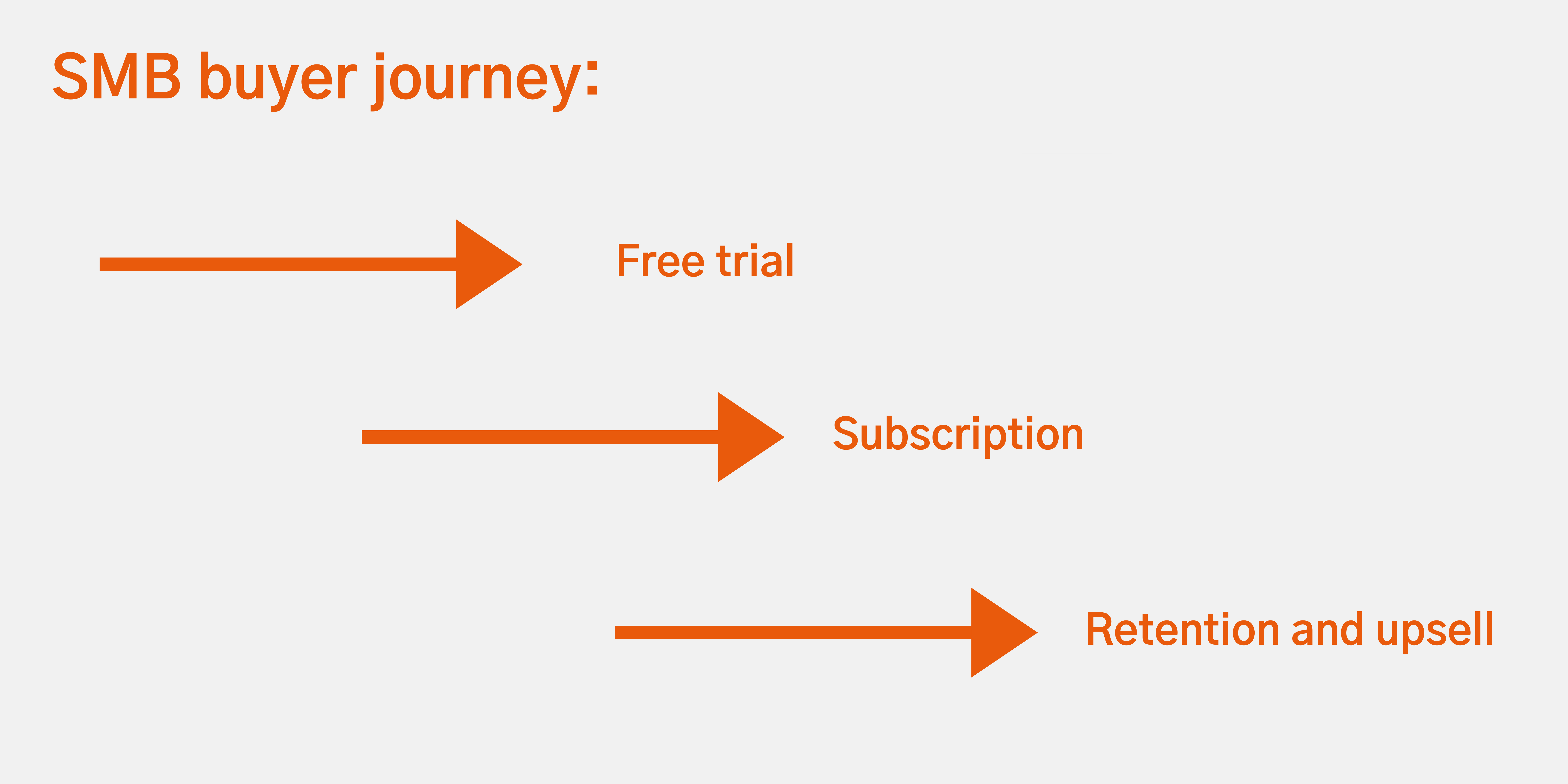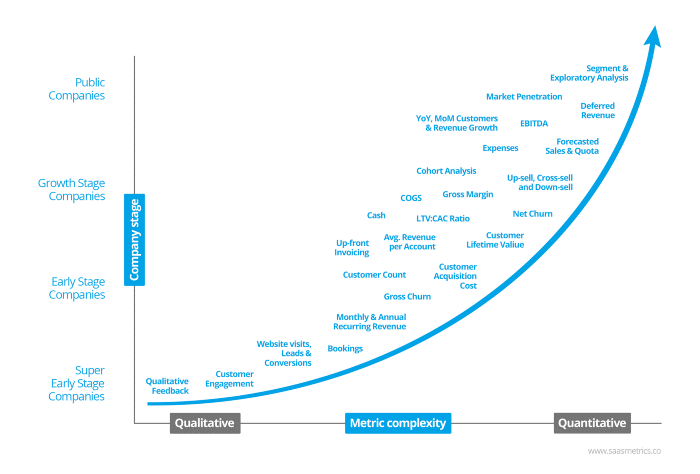The SaaS (Software as a Service) sector continues to evolve at breakneck speed - but are you measuring the right Marketing metrics to know whether you are on track? In this article we’ll outline:
- Key Performance Indicators (KPIs) for SaaS - relevant to each business maturity stage (early-stage, growth and scale, maturity)
- Why SaaS metrics become more complex during growth and scale
- The importance of aligning KPIs with your business model
Evolve your metrics with your business objectives
The technology market space is expanding at a rapid pace; with the highest-performing SaaS companies growing at an average pace of 56% per year.
That’s a rapid evolution! In fact, the market overall is expected to reach a staggering $623 billion by 2023.
As a result, SaaS businesses face increasing pressure to adapt and grow. It’s easy to get overwhelmed by the number of metrics you can measure!
But, instead of getting caught up in what you ‘should’ be measuring, the key is to tailor your focus around your business objectives.
After all, if your KPIs don’t align with your business goals, why are you measuring them?
And, as a SaaS business expands and evolves, chances are your metrics will also need to adapt.
Success for an early-stage organization looks different than at a Mature level.
That’s why it’s crucial to focus on a few core metrics to begin with, and update the list as your organization scales.
“Your company challenges and priorities evolve over time, and your metrics should reflect that” - SaaSholic
As the metrics you choose to measure will depend on your company’s level of SaaS maturity (among other factors), below we’ll break down the key metrics to measure for these stages of the SaaS lifecycle:
• Product/Solution fit
• Product/Market fit
• Rapid Scale
• Maturity
So let’s dive into it!
Marketing KPIs at the product/solution fit level
Whether you’re just starting to build your business, or you have the foundations in place but are still figuring out what the best approach is - early-stage SaaS businesses need to focus on building their values and key objectives.
Of course, the most important thing to consider is how you aim to fit into the market.
Ask yourself: what is the problem that needs to be solved, and how is your solution going to solve it?
As a smaller, early-stage SaaS business, chances are your objectives revolve around expanding and growing.
This may mean you opt for a product-led growth strategy, whereby the prospect can sign-up for a product trial or full usage of a product at a low tier for free.
This allows your customer to get a taste of your product before committing, meaning your challenge is to hook them!
“The challenge for the vendor is to convert this customer from a free user to a paid user” - Fes Askari, Director of Sales and Strategic Accounts at strategicabm
Product-led growth puts the impetus on the buyer to navigate their own buyer journey, as often this is low-touch and doesn’t require engagement from a vendor sales team, making it a popular model for early-stage businesses.

What Marketing KPIs should you measure at the product/solution fit level?
For these early-stage SaaS businesses, the metrics you use are likely to be more qualitative.
For instance, customer feedback will play a key role in assessing the success of your marketing efforts.
Why?
Simply put, this is the perfect opportunity to get feedback directly from your audience to really gain a deeper understanding of their pain points.
As your business grows, you’ll lose (somewhat) the opportunity to gain this kind of feedback as your audience will be at a much larger scale. This is when you’ll begin to turn to more quantitative metrics that are perhaps more scalable.
You also want to look at figures like conversions, as this will give you a fairly accurate indication of the appeal of your solution and value proposition.
Marketing KPIs at the product/market fit level
At this stage, you have now started to gain momentum, started the journey and should be starting to see growth.
This is where you begin to pull towards more quantitative metrics.
We’re still early-stage here, but metrics to measure at product / market fit level include:
Cost per Acquisition (CPA) / Customer Acquisition Cost (CAC)
Understanding how much it costs to acquire customers is an important metric for any business - after all, you need to know that your marketing channels are cost-effective.
And whilst it may sound complex, a simple equation will give you the number you’re after.
Simply take all Marketing and Sales costs (including headcount), and divide this by the number of customers acquired.
Et voila! You have your CAC!
Note that this metric is influenced by the quality of traffic and leads you’re generating in the first place.
After all, if the leads you’re generating are mostly a good fit, they’re more likely to close.
Over time, this will reduce your CAC.
Customer Lifetime Value
If revenue is the prime goal - which, for the vast majority of businesses, it is - you want to keep tabs on how much the customers you’re converting are worth over the course of their lifetime with you (CLV).
For SaaS businesses - who tend to use subscription-based models - you need to consider this source of recurring revenue as a benchmark for forecasts, and (linked to monthly recurring revenue) as an indicator of growth.
By working out your CLV, you’ll be in a better position to find out:
- The average value of each customer
- How often each customer purchases from you
- How much a customer spends with you
Whilst there are, of course, countless other metrics that you can track at this stage, CAC and CLV are two essentials if you hope to continue expanding your SaaS business.
Marketing KPIs at the Rapid Scale level
This is where things start to pick up speed!
If you’re in this stage of the SaaS lifecycle, chances are you’re beginning to see faster and more substantial growth.
And as your SaaS business grows and moves through the lifecycle, your metrics will start to get a little more complex to fit a more complex sales cycle.
But what do I mean by that?
As you start to move towards the enterprise-level, your business model is likely to change to fit the changing needs of your audience - as will the way in which you engage with your customers.
For instance, you may decide to place a high price on access to your technology, because the value and need from the buyer is greater; for example, managing complex databases, workflows, or project management.
Why does this make the sales cycle more complex?
Often more enterprise technology purchases are made by a buying committee and therefore a more complex sales cycle is delivered, to help educate and meet the needs of stakeholders within the buyer’s organization.
And this requires an ‘assisted’ sales process, often referred to as a ‘solutions sale’.
As such, you’re going to need some deeper-level metrics.
Marketing KPIs to consider at the Rapid Scale level
Upselling
On average, 70-95% of revenue comes from upsells and renewals. So if you’re looking to boost your revenue, tracking upsells is an absolute must!
This will be a key contributor to customer retention, as keeping your customers loyal with upgrades and improvements will keep them interested in your brand.
Churn
Unfortunately, whilst your ultimate goal is to retain and upsell your existing customers, it’s inevitable that some of your customers will leave.
That’s why it’s essential that you, firstly, track your churn rate (monthly or quarterly), and secondly, identify the reasons behind lost business to minimize future issues.
Be sure to look at the persona profiles of churned cases; budget, industry, plus any other information that can help you define what makes a good or poor-fit customer in the future.
Monthly Recurring Revenue (MRR)
Of course, if you’re wanting to track your growth, one of the key metrics to keep an eye on is revenue. After all, revenue growth is the ultimate indicator of success!
As mentioned above, most SaaS businesses run on a subscription basis (typically per-month, or per-year) so recurring revenue comes from renewed clients as well as new revenue from new business.
Identifying the recurring revenue you can expect to see on a month-by-month basis (as well as total monthly revenue) is important to establish that you’re sustainable and growing - particularly after you factor in churn rate.
Marketing KPIs at the Maturity level
Once your SaaS business is securely within the maturity stage, you will already have a fairly comprehensive set of metrics to track.
But as you’re now working at a more enterprise-level, it’s increasingly important that the metrics tracked here are more focused on the quality of prospects engaged within the Sales & Marketing funnels.
“From a marketing perspective, there is a greater need to track attribution as the sales process is longer and more convoluted than a product-led growth acquisition journey” - Fes Askari, Director of Sales and Strategic Accounts at strategicabm
You’ll also want to look at conversions and engagement at key buyer stages - from Top of the Funnel (TOFU), through to Bottom of the Funnel (BOFU).
Arguably the most important metric at this stage is recognized revenue.
Essentially, revenue is only counted once the service or product has been delivered to the client.
But why is this so important for SaaS businesses in the maturity stage?
Ultimately, it allows the business to keep a more accurate view of your achievements, without celebrating false victories. After all, until the promised service has been delivered, the deferred revenue is just another liability.
Base Marketing KPIs on SaaS maturity - and your specific business
Of course, the metrics your business chooses to measure are dependent on various factors beyond just your level of SaaS maturity - it also depends on your business model, size, objectives, and sales process model.
But the stage of your business in the SaaS lifecycle should certainly be a contributing factor when deciding your KPIs, and these should be reviewed and updated as your company grows.
No single metric can determine success, but combined, the above are good base indicators of the growth and progress of your activities.








